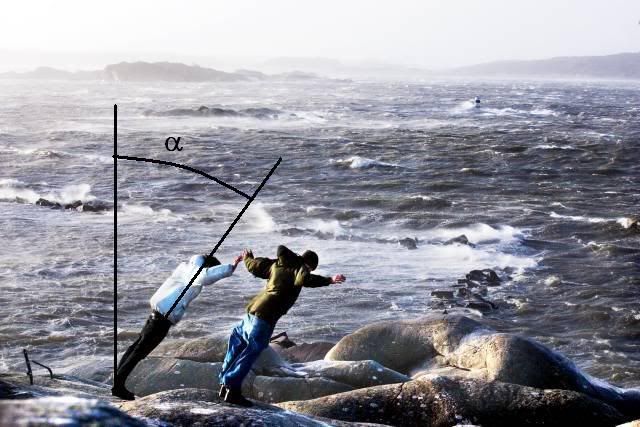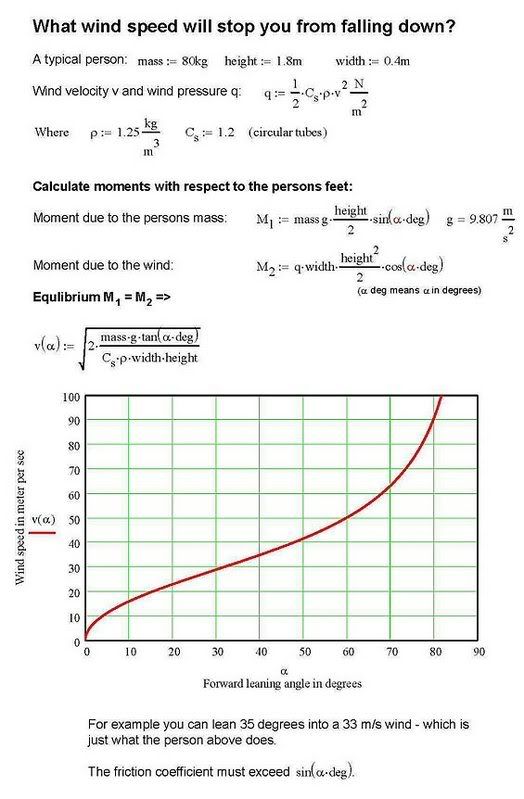Page 1 of 3
What wind speed will stop you from falling down?

Posted:
Mon Jan 15, 2007 8:14 pmby hansw
In another thread it was asked “what wind speed will knock you down?” It may also be of interest to ask “what wind speed will stop you from falling down?” - Or how much can you lean into the wind for a given wind speed?

Picture credit: Stefan Berg

Posted:
Tue Jan 16, 2007 8:28 pmby hansw
Since I said A I may as well say B. Here goes:


Posted:
Wed Jan 17, 2007 10:48 pmby live2climb

Posted:
Wed Jan 17, 2007 11:00 pmby FF_Spectre
It's only funny until the wind suddenly dies out and you fall on your face. Then it's HILARIOUS!

Posted:
Wed Jan 17, 2007 11:11 pmby Vladislav
Nice post!
Simple physics will also tell you that spreading your arms does help. Now, would anybody care to estimate how much further a person will be able to lean into the wind by spreading his/her arms? Extra credit for that!

Posted:
Wed Jan 17, 2007 11:14 pmby Chris
It would probably depend on how much I've had to drink before I tried leaning into the wind


Posted:
Thu Jan 18, 2007 1:57 amby brenta
One factor to be considered is that one can lean forward in still air as long as the center of gravity projects onto one's feet. If one's center of gravity were approximately half way up, one could lean forward quite a bit, but in most cases, the center of gravity is higher and one can lean forward only a few degrees.
As for spreading arms, most of the advantage comes from one's jacket's catching more wind. Under the assumption that the cross section remains constant, the arms of both moments increase, and it's a matter of whether you move up a greater precentage of the cross section or of the mass. There should still be a slight advantage, because the arms are thinner than the trunk.

Posted:
Thu Jan 18, 2007 2:16 amby Windcatcher
I did some quick calculations with my ice axe:

This is what I came up with as a crude anemometer. You hang it with a biner thru the sling hole. Here is the chart:

You can use it two ways: either hang in by the adaze or with an accessory biner through the hole in the spike. The two curves are different, because of different shaft area, different moment of inertia, and the role of adaze in the spike configuration. For reference, 30m/s is 67.5 mph.
Now, I need to get out and field test it.

Posted:
Thu Jan 18, 2007 4:20 amby ksolem
Kevin Thaw once descibed to me a situation descending off Fitzroy where he was blown upwards while rapelling and then dropped when the wind stopped.


Posted:
Thu Jan 18, 2007 4:11 pmby hansw
Good idea Windcatcher. By a small device on you ice-ax you can read the wind speed. US patent No. ?

Posted:
Thu Jan 18, 2007 5:33 pmby Big Benn
The warm Atlantic Ocean is giving us some unusually windy weather here in South East UK. So I was able to "walk" along the top of the White Cliffs of Dover in winds faster than anything I have been out in yet. From the local weather ship data I can say that:-
I can just about stay standing in an upright position for very short gusts of around 85 mph.
For short gusts up to around 90 mph I can stay standing only if I am bent forward quite a lot, (ie just able to move forward and not quite down on all fours),
For a short gust of 95 mph, (this seems to be the highest gust today when I was walking on the Cliffs), I get knocked to the ground, even if my starting position was bent forward quite a lot!
Thankfully I had the good sense to take the highest and most wind exposed path today, which was a little further away from the Cliff edge to my normal routes. Four and a half of the most exhilerating hours of my life! All in quite heavy rain, as well as the wind.
Very sadly at least seven people are already reported as being killed by the gales in the UK today.

Posted:
Fri Aug 22, 2008 6:48 pmby brenta
EDIT: Algebra mistake on my part. I lost a cos(alpha) somewhere along the way. Having recovered it, I find that mu should be at least tan(alpha).

Posted:
Fri Aug 22, 2008 8:36 pmby Lockhart
Interesting thread, all. I've thought of making that ice axe anemometer plot many times.
@brenta: Good input.
Around 45-degrees or so, the aerodynamic effects of the wind would probably be an issue, too. Turbulence at the back-end of the cylinder (or person) would create a lower pressure region - much like putting your hand out of the window of a moving car. This would accentuate the lifting effect brenta mentioned. So, I'd think that the figure at the top of the thread is reasonable accurate up to 45-degrees, and then probably much less so at angles above 45-degrees.

Posted:
Fri Aug 22, 2008 10:26 pmby Moni
Wind speed estimate for those of us who don't pack calculators in our climbing packs. Fred and I aborted a climb a few weeks ago, because the wind was knocking us off balance while boulder hopping. You could do the lean into the wind thing as in the first frame of this thread (and, yes, it was funny when I fell over once when the wind died back). We figure it was a steady 45 mph with gusts of 50+ or so.

Posted:
Sat Aug 23, 2008 12:26 amby Kai
On a winter trip to Long's Peak, I was blown across (frozen) Chasm Lake. The wind just pushed me across the ice.



 This is what I came up with as a crude anemometer. You hang it with a biner thru the sling hole. Here is the chart:
This is what I came up with as a crude anemometer. You hang it with a biner thru the sling hole. Here is the chart:
